Crafting Magnolia Spice: A Floral Delight for our Kitchen
In our continuous exploration of natural ingredients and homemade spices, we've turned our attention to an unexpected but delightful source: magnolia blossoms. Known for their majestic beauty and aromatic presence in gardens, these blossoms also offer a unique culinary potential.
By transforming magnolia petals into a versatile spice powder, we've found a delightful addition to pancakes, cookies, and dishes that traditionally use cinnamon, cardamom, clove, or ginger.
The process of turning magnolia blossoms into spice involves two methods: oven roasting and air drying, each yielding distinctly different flavors. The oven-roasted petals develop a coffee-dark color and richer, more cardamom-like notes, while the air-dried petals, hung in our chandelier, maintain a lighter, more citrusy floral essence.
Harvesting and Preparing the Petals: Begin by carefully gathering the bulbous magnolia flowers. Gently separate the petals from the flower base, taking care to keep them intact for even drying.
Drying the Petals: For air drying, string the petals together and hang them in a dry, well-ventilated area, such as from a chandelier. This method enhances their floral and citrusy notes. Allow about five days for the petals to dry completely.
Oven Roasting the Petals: For a deeper, spice-like flavor, spread the petals on a baking sheet. Toast them in the oven at 356°F (180°C) for 5-10 minutes, until they take on a dark, rich appearance.
Creating the Spice Powder: Once dried, whether air-dried or oven-roasted, the petals are ready to be pulverized into a fine powder. Use a spice grinder or mortar and pestle to grind the petals.
Storage: Store the magnolia spice powder in an airtight container, away from light to preserve its aromatic qualities.
Pictured above: Toasted petals.
The dark powder, roasted petals. The lighter, air-dried petals.
This homemade magnolia spice adds a unique twist to many recipes. Its compatibility with warm spices makes it an excellent addition to baked goods and seasonal dishes.
However, it's important to note that while magnolia petals are a delightful culinary ingredient, they can cause allergic reactions in some people, particularly when un-toasted. We recommend cautious experimentation, sparingly use, - particularly with the air-dried variety - , and suggest starting with small amounts to ensure compatibility.

















